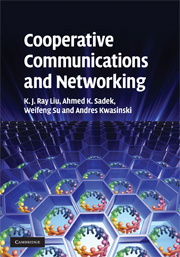Book contents
- Frontmatter
- Contents
- Preface
- Part I Background and MIMO systems
- Part II Cooperative communications
- Part III Cooperative networking
- 11 Cognitive multiple access via cooperation
- 12 Content-aware cooperative multiple access
- 13 Distributed cooperative routing
- 14 Source–channel coding with cooperation
- 15 Asymptotic performance of distortion exponents
- 16 Coverage expansion with cooperation
- 17 Broadband cooperative communications
- 18 Network lifetime maximization via cooperation
- References
- Index
17 - Broadband cooperative communications
from Part III - Cooperative networking
Published online by Cambridge University Press: 06 July 2010
- Frontmatter
- Contents
- Preface
- Part I Background and MIMO systems
- Part II Cooperative communications
- Part III Cooperative networking
- 11 Cognitive multiple access via cooperation
- 12 Content-aware cooperative multiple access
- 13 Distributed cooperative routing
- 14 Source–channel coding with cooperation
- 15 Asymptotic performance of distortion exponents
- 16 Coverage expansion with cooperation
- 17 Broadband cooperative communications
- 18 Network lifetime maximization via cooperation
- References
- Index
Summary
In broadband communications, OFDM is an effective means to capture multipath energy, mitigate the intersymbol interference, and offer high spectral efficiency. OFDM is used in many communications systems, e.g., wireless local area networks (WLANs) and wireless personal area networks (WPANs). Recently, OFDM together with time–frequency interleaving across subbands, the so-called multiband OFDM [9], has been adopted in the ultra-wideband (UWB) standard for wireless personal area networks (WPANs).
To improve the performance of OFDM systems, the fundamental concept of cooperative diversity can be applied. Nevertheless, special modulations/cooperation strategies are needed to efficiently exploit the available multiple carriers.
In this chapter, we study an OFDM cooperative protocol that improves spectral efficiency over those based on fixed relaying protocols while achieving the same performance of full diversity. By exploiting limited feedback from the destination node, the described protocol allows each relay to help forward information of multiple sources in one OFDM symbol. We also describe a practical relay assignment scheme for implementing this cooperative protocol in OFDM networks.
System model
In this section, we describe the system model of a wireless network, in which we take into consideration the random users’ spatial distribution. The channel model, the signal model, and the performance measure in term of outage probability are discussed.
We consider an OFDM wireless network such as a WLAN or a WPAN with a circular cell of radius ρ. The cell contains one central node and multiple users, each communicating with the central node.
- Type
- Chapter
- Information
- Cooperative Communications and Networking , pp. 569 - 582Publisher: Cambridge University PressPrint publication year: 2008
- 3
- Cited by



